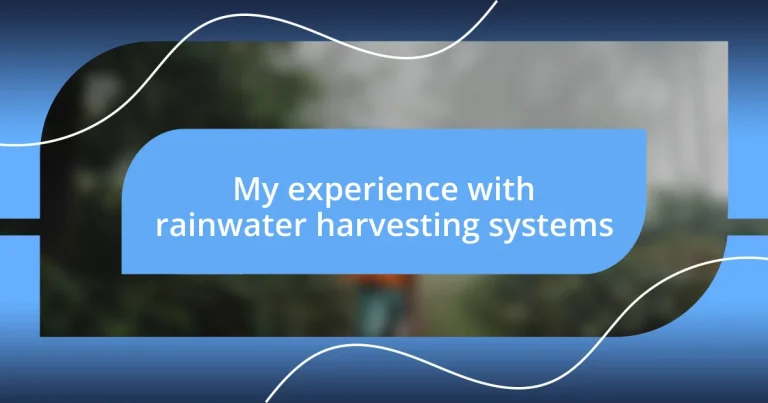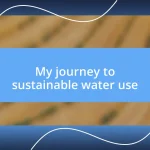Key takeaways:
- Rainwater harvesting connects individuals with nature, empowering them to take control of their water resources and contribute to sustainability.
- The system offers significant benefits such as cost savings, resource conservation, flood prevention, and drought resilience.
- Maintenance and community engagement are vital for success, helping to inspire others and enhance the shared experience of sustainable practices.
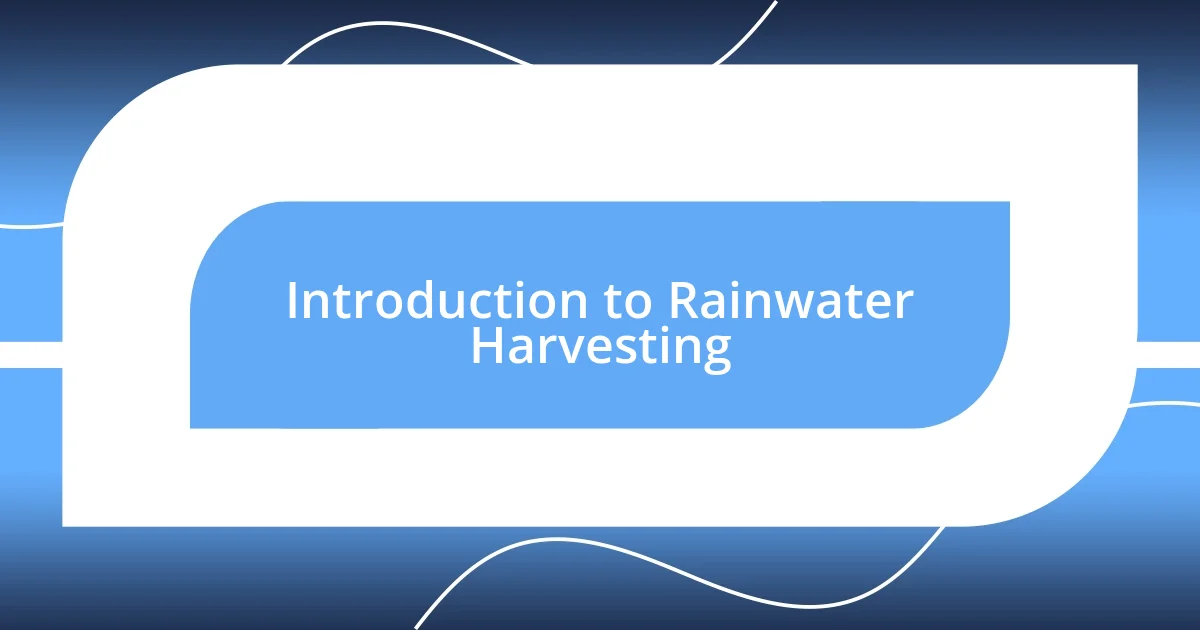
Introduction to Rainwater Harvesting
Rainwater harvesting has always fascinated me because it connects us so intimately with nature. I remember my first encounter with a rain barrel during a community workshop. Watching it fill up with precious water during a downpour sparked a realization: here was a simple solution to a growing concern about water scarcity.
As I delved deeper into the concept, I found myself pondering why we often overlook such a valuable resource. Every drop of rain that falls on our roofs could be transformed into drinking water, agricultural supplies, or irrigation. Isn’t it amazing to think how nature has provided us with a free water source, just waiting for us to capture it?
Beyond just an environmental choice, rainwater harvesting offered me a sense of empowerment. I started to feel like I was taking responsibility for my water usage and contributing to a sustainable future. Can you imagine standing in your garden, knowing that each plant thrives from water you’ve collected and nurtured? The experience truly changed my perspective on resource conservation.
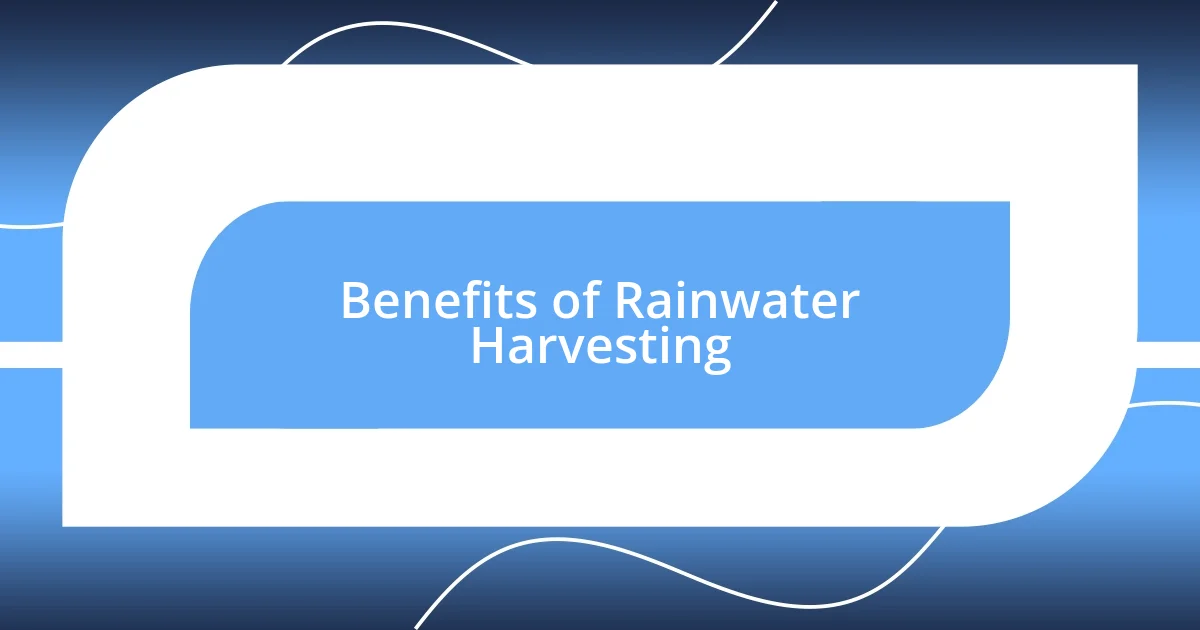
Benefits of Rainwater Harvesting
Rainwater harvesting provides numerous benefits that can transform not only our households but also our communities. Personally, I’ve discovered that capturing rainwater can dramatically reduce water bills, which is something I didn’t envision at first. It felt rewarding to see that after a heavy rain, my storage tanks had filled up, ensuring my garden remained lush without additional expenses. This system offers an opportunity to conserve water while making a positive impact on the environment.
Consider the following advantages of rainwater harvesting:
- Cost Savings: Reduced water bills by using collected rainwater for irrigation and household needs.
- Resource Conservation: Less reliance on municipal water supply, leading to more sustainable water management.
- Flood Prevention: Helps mitigate local flooding by capturing stormwater runoff.
- Water Quality Improvement: Rainwater is typically free of minerals and chemicals found in treated water.
- Drought Resilience: Provides a reliable source of water during dry spells, securing gardens and farms.
I’ve often marveled at how simple systems like cisterns can play such a critical role in pushing back against water shortages, reinforcing my belief that every drop counts. It’s like having a secret weapon against climate unpredictability, making me feel more prepared to face future challenges.
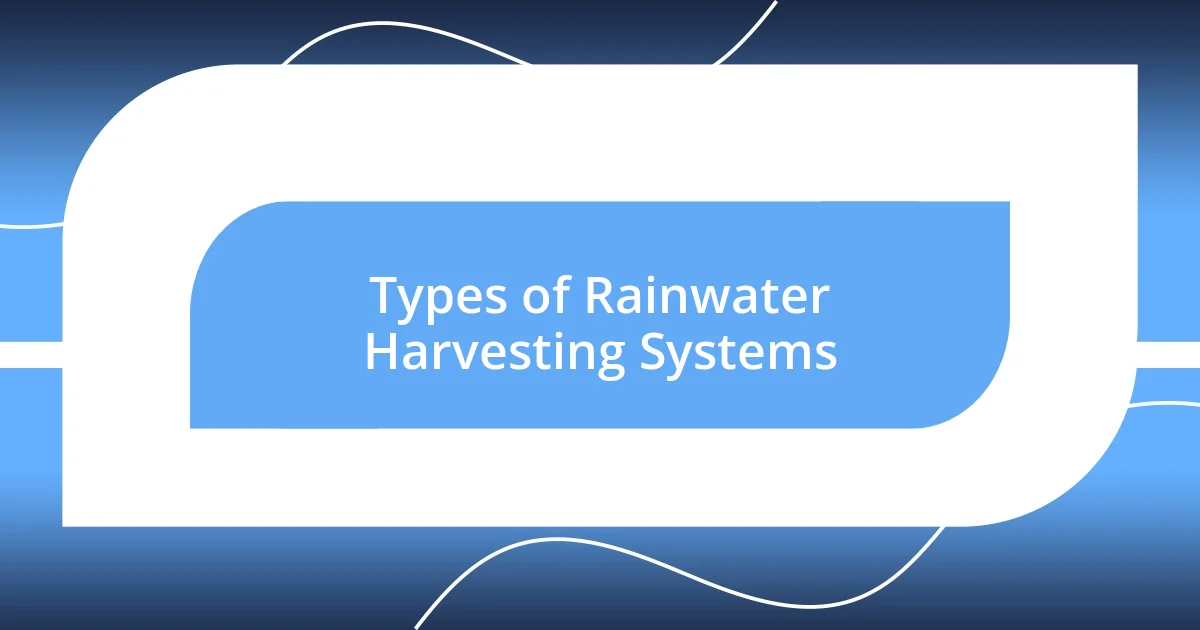
Types of Rainwater Harvesting Systems
When it comes to rainwater harvesting systems, there are a few primary types that I’ve encountered in my journey. The most common is the rain barrel, often placed beneath a downspout to collect water from rooftops. I vividly remember the day I set up my first rain barrel—it was surprisingly straightforward! Watching the rain collect in that barrel felt like I was gathering little treasures from the sky. It’s perfect for watering small gardens or keeping houseplants thriving during dry spells.
Another system I explored is the cistern, which is typically a larger underground storage tank. While helping a neighbor install hers, I realized how essential these systems can be for larger properties. The underground aspect keeps the water cool, reducing evaporation. This setup can hold enough rainwater to support a family’s needs, especially in areas where drought can sizzle the landscape. It made me appreciate just how versatile rainwater harvesting can be for both residential and agricultural use.
Lastly, what really intrigued me were green roofs. These systems are not only environmentally friendly; they also serve as a living wall of insulation. The day I helped transform a standard roof into a vibrant garden was unforgettable. We could see rainwater filtering through the plants, promoting biodiversity while capturing precious water at the same time. It’s fascinating to think about how rainwater harvesting can integrate into modern architecture, creating a harmonious balance between nature and the built environment.
| Type of System | Description |
|---|---|
| Rain Barrel | Small containers placed under downspouts to collect rooftop rainwater, ideal for gardens. |
| Cistern | Larger underground tanks used to store rainwater for household or agricultural use. |
| Green Roofs | Vegetated roofs that capture rainwater, promoting insulation and biodiversity. |
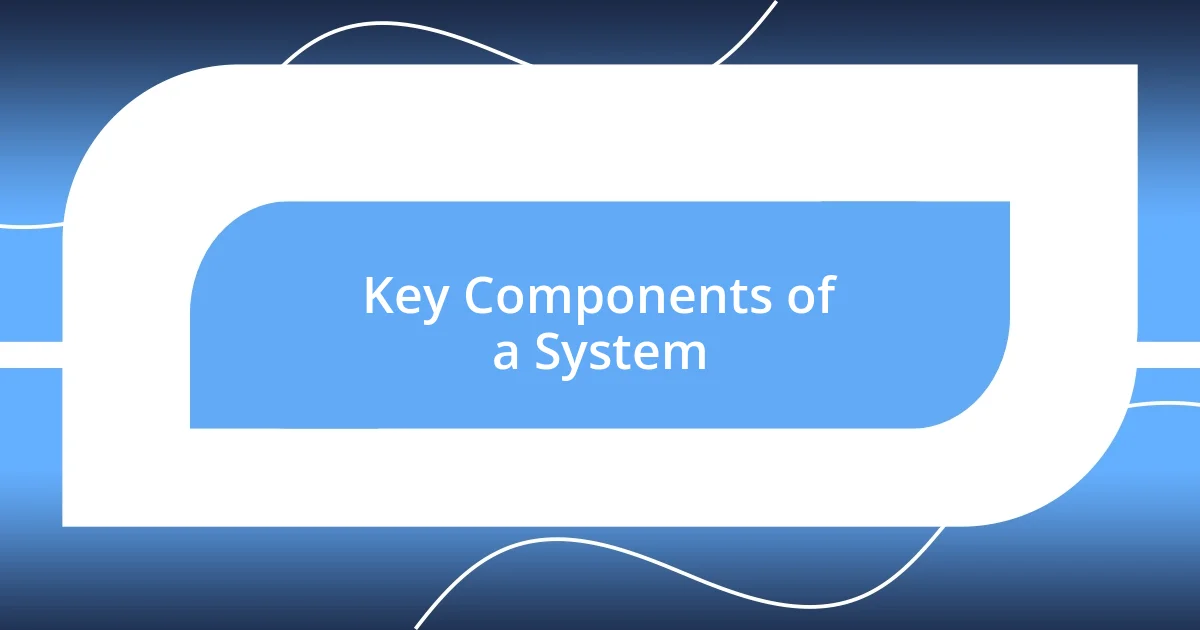
Key Components of a System
The key components of a rainwater harvesting system typically include a collection surface, a storage system, and a conveyance system. When I set up my collection system, the first step was determining the best collection surface—my roof. It’s amazing to realize how much water can be captured just from those few square feet!
Next comes the storage aspect. I opted for a storage tank that could hold several hundred gallons. Every time it rains, I can’t help but feel a thrill watching the gauge rise, knowing I’ve secured a reliable water source. It’s the kind of satisfaction that comes from being proactive. Have you ever felt that rush of joy when you’re preparing for something that you know will benefit you later? That’s what it feels like each time I check my tank.
Finally, the conveyance system is key to directing the water where it’s needed. I spent a weekend learning to install the necessary pipes and faucets, which was both challenging and exhilarating. This step isn’t just a technical aspect; it’s a creative process, too! It’s like piecing together a puzzle. I often ask myself how much easier life would be if everyone knew about these systems and their potential, and I certainly want to share that knowledge.
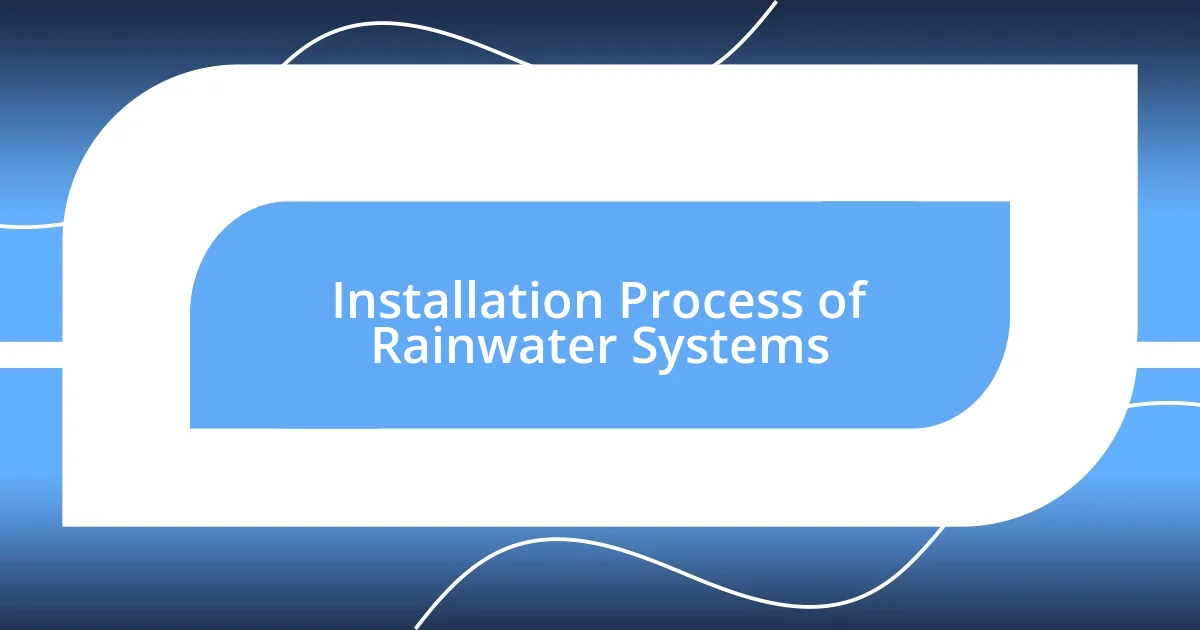
Installation Process of Rainwater Systems
Installing a rainwater harvesting system is a project that, while it may seem daunting, is incredibly rewarding. The first step I took was assessing where to position the collection and storage systems. I remember standing on my porch, looking at my roof and downspouts, and realizing just how much potential I had right above my head. Isn’t it amazing how we’ve overlooked such a valuable resource?
Once I decided on the location, it was time to dig in—literally! If you’re installing a cistern, the excavation process is a big part of the job. I vividly recall the excitement of my friends and family rallying around to help. As we dug, the chatter of our laughter fit perfectly with the anticipation of what was to come. There’s a camaraderie in these types of projects that makes the work feel lighter. It’s like hosting a mini-event where everyone contributes to something meaningful.
Finally, connecting the pipes can be a bit of a puzzle. I found myself double-checking every joint and connection, ensuring that everything was watertight. The feeling of satisfaction when I turned on the system for the first time was unmatched—I could hardly contain my excitement! The sight of that clear rainwater flowing smoothly through the pipes brought a sense of achievement that I can only equate to finishing a challenging book. Have you ever experienced the joy of seeing a project you worked hard on come to life? It’s truly one of those moments worth savoring.
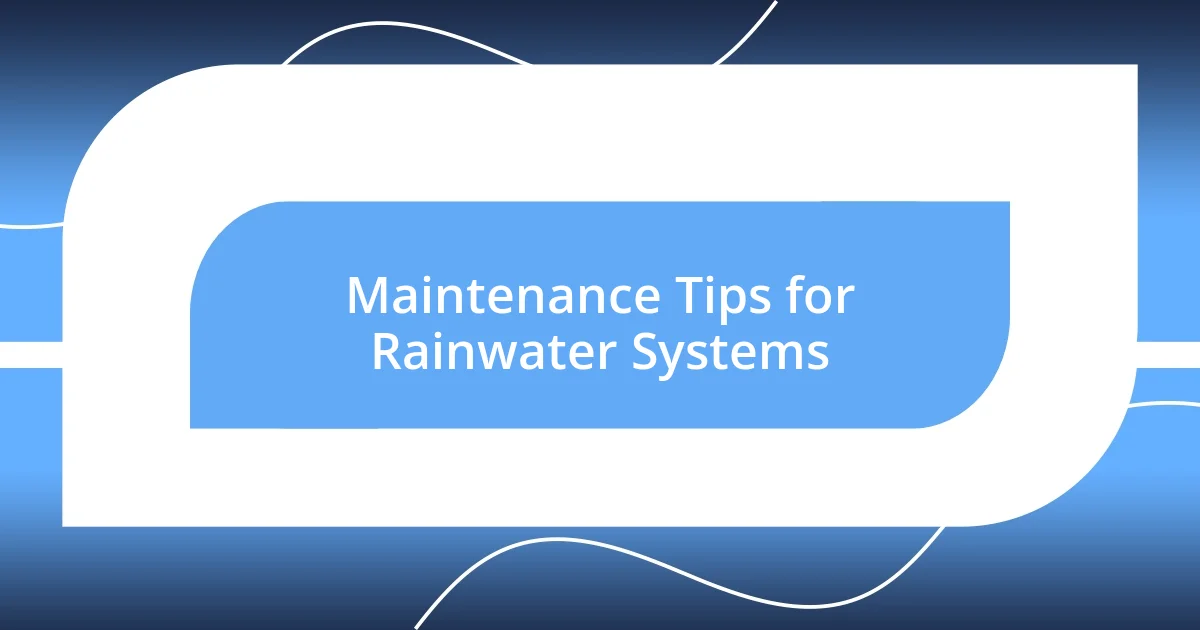
Maintenance Tips for Rainwater Systems
Maintaining a rainwater harvesting system is crucial for its longevity and efficiency. From my experience, regular cleaning of the gutters and filters is essential. I remember the first time I neglected to check them—after a heavy rain, I was baffled as to why my tank wasn’t filling up. It turns out that a small build-up of leaves had completely blocked the flow. Have you ever ignored a simple task, only to face bigger consequences down the line?
Another tip I’ve learned is to inspect the storage tank periodically for any signs of algae or sediment build-up. After a few months of use, I was surprised to find some debris floating at the surface of my tank. A little bit of maintenance goes a long way; spending a few hours cleaning can save you from losing a significant amount of water down the line. It’s like spring cleaning for your water system—a refreshing task that yields wonderful dividends!
Lastly, I can’t stress enough the importance of checking all pipes and connections. One chilly morning, I noticed a small leak near a joint, and it was a reminder of how quickly issues can escalate if left unchecked. If I hadn’t caught that early, I could have faced bigger headaches and more repairs. By dedicating time each season to these checks, we can ensure our systems run smoothly and efficiently. What could be more rewarding than knowing you’re taking proactive steps to maintain your own resource?

Personal Insights and Experiences
It’s fascinating how my perspective on water changed after installing my rainwater harvesting system. One week after everything was up and running, I sat in my garden during a gentle rain. I watched as the droplets danced on the roof and then cascaded down the downspouts into my tank. The tranquility of that moment made me realize I was harnessing nature’s gift—something I had taken for granted for so long. Have you ever paused to appreciate the power of a simple rain?
Another memorable experience was during a community workshop I held to share what I learned. I invited neighbors over to see my system and to discuss the benefits. As I demonstrated the filter setup, I watched their expressions shift from skepticism to intrigue. One guy even said, “If you can do this, why can’t I?” That conversation opened a door for many in my neighborhood to explore their own solutions, and it filled me with pride to know I could inspire change.
Emotions really ran high during our first summer of use. As we welcomed guests to our annual barbecue, I found myself bragging about my rainwater system. Honestly, I felt a swell of accomplishment when my friends sipped on drinks mixed with water I had collected myself. That moment proved that sustainability can bring us together, turning a simple effort into a communal celebration. What have you done recently that made you feel both proud and connected to your environment?












